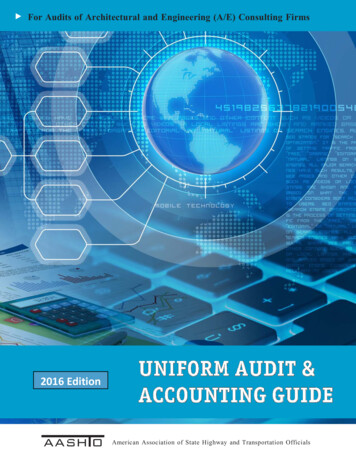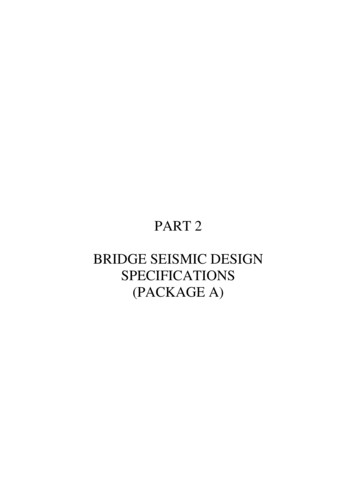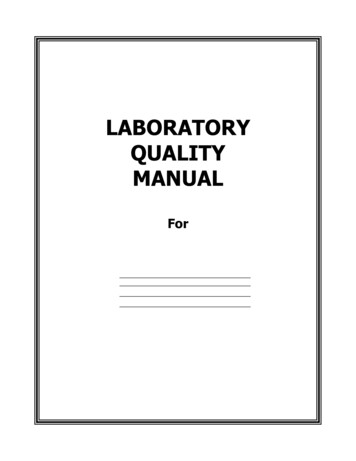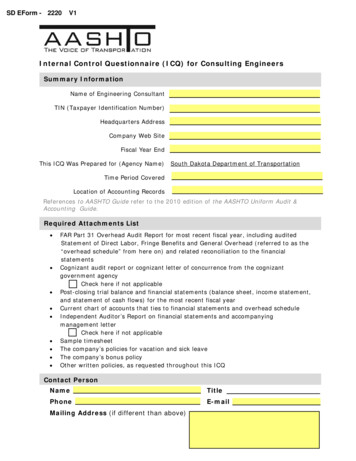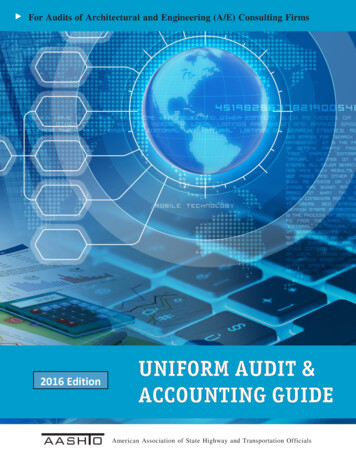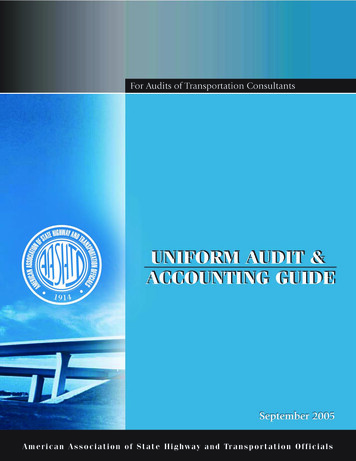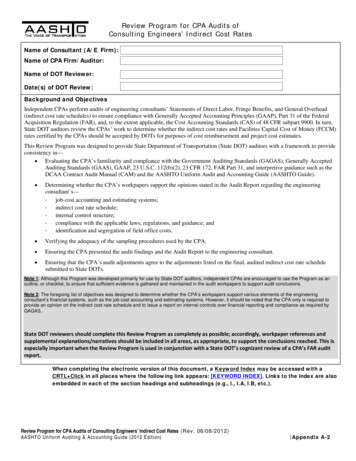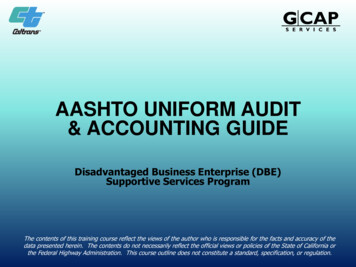
Transcription
AASHTO UNIFORM AUDIT& ACCOUNTING GUIDEDisadvantaged Business Enterprise (DBE)Supportive Services ProgramThe contents of this training course reflect the views of the author who is responsible for the facts and accuracy of thedata presented herein. The contents do not necessarily reflect the official views or policies of the State of California orthe Federal Highway Administration. This course outline does not constitute a standard, specification, or regulation.
ABOUT THE GUIDE PURPOSE Assist users in understandingterminology, policies, proceduresand sources for applicable FederalRegulations Define contract cost principlesand procedures as set forth inTitle 48, Chapter 1, Part 31. To encourage users to adoptuniform accounting and reportingprocedures2
ABOUT THE GUIDE To encourage users to adopt uniform accounting and reportingprocedures including but not limited to, labor charging systems,cost accumulation and reporting practices, and the format andcontent of statements of direct labor, fringe benefits and generaloverhead (“indirect cost rate schedules”).3
ABOUT THE GUIDE SCOPE & APPLICABILITY Construction and architectural-engineering (A&E) contracts. Private consulting firms providing architectural, landscapearchitectural, engineering, environmental, land surveying, orconstruction management services are termed Architecturaland Engineering Consultants (A&E).4
ACCOUNTING SYSTEM CONTRACTS WITH CALTRANS In order to successfully compete for a contract with Caltrans andmeet potential audit requirements, a contractor (whether aprime or subcontractor) must have a system of record keepingand internal control. An award may be delayed or even not awarded at all if youraccounting system does not meet certain criteria set forth byCaltrans or local transportation agencies5
ACCOUNTING SYSTEM OBJECTIVES Due to the nature of the types of contracts awarded (cost,reimbursable, time and materials, cost plus and firm fixed price),the government contracting industry imposes unique burdens ona contractor’s accounting system. It must employ the followingbasic processes before it will pass a potential audit:1.2.3.A job order cost accounting system considered adequate toidentify, account for, record and accumulate project costs. Eachproject is assigned a job number so that project costs can besegregated and accumulated in the accounting system.Ability to identify and segregate direct and indirect projectcosts on a consistent basis.Employ a logical and consistent method for the allocation ofindirect costs6
ACCOUNTING SYSTEM4.5.6.7.8.9.Costs are accumulated under General Ledger control.A timekeeping system that identifies labor by cost objective andallocates this time properly.While construction contractors must adhere to the cost principles ofTitle 48, CH1, Part 31, the overhead rates on Construction contractsare developed completely different than A&E contracts.Interim determination of costs.Segregation of unallowable costs.A system of internal control which provides reasonable assurance thatassets are protected; financial data, records and statements arereliable; and errors and irregularities are promptly discovered,reported, and corrected.7
ACCOUNTING SYSTEM SEGREGATING DIRECT COSTS FROM INDIRECT COSTS Direct costs are defined in FAR 31.202 as any cost thatcan be identified specifically with a particular final costobjective (e.g; a contract). An example would be laborspecifically identified to the contract or materialspurchased specifically for the contract.8
ACCOUNTING SYSTEM Indirect costs are defined in FAR 31.203 as any cost notdirectly identified with a single or final cost objective,but can be allocated to two or more final cost objectives.An example would be administrative costs incurred bycorporate headquarter. The administrative costs incurredbenefits all projects, but cannot practically be identifiedwith any particular project or final costs objective.9
ACCOUNTING SYSTEM ACCUMULATING ANDSEGREGATING COSTS The ability to accumulate andsegregate reasonable, allocable(incurred solely for a project) andallowable (per terms of thecontract) costs through the useof a cost accounting system(commonly referred to as a jobcost accounting system). Thefollowing are some attributeswhich would ideally be found insuch a system:10
ACCOUNTING SYSTEMa.b.c.A chart of accounts which includes indirect, direct, andunallowable general ledger accounts.Segregation of costs by contract, and in some instancesby cost category and milestones (if applicable)Proper recording of direct and indirect costs. Forexample, recording of labor costs should provide thatadministrative labor hours be recorded on a timesheetand accumulated in the accounting records to a fringebenefit, vacation, sick leave or other indirect costaccount/code. Direct project hours should be recordedon a timesheet and in the payroll records to a directproject cost account/code.11
ACCOUNTING SYSTEMd.Consistent accounting treatment of costs in recordingand reporting. For example, if copy/printing expenseis charged directly to a project, all copy/printingexpense incurred on any project should beconsidered a direct cost. As a result, project relatedcopy/printing, whether reimbursable per the contractterms or not, should not be included as an indirectcost pool.12
ACCOUNTING SYSTEMe.f.Ability to trace from invoices submitted to job costrecords and original, approved source documents, forexample, timesheets, vendor invoices, cancelledchecks.Ability to reconcile job cost records (i.e, subsidiaryrecords) to accounting and payroll records (i.e., G/L).13
ACCOUNTING SYSTEM ALLOCATION OF INDIRECT COSTS Indirect costs are allocated to cost objectives based uponrelative benefits received or other equitable relationship, asrequired by FAR 31-201-4. Such costs need to be groupedinto logical categories (i.e. fringe, overhead, G&A, etc.) thenallocated to every contract based on a definedmethodology. An example of this would be to allocateoverhead on the basis of direct contract labor dollars. Themethodology employed should be consistently applied to allcost objectives.14
ACCOUNTING SYSTEM Per FAR 31-201-4 a cost is allocable to a governmentcontract if it:a. Is incurred specifically for the contract; orb. Benefits both the contract and other work, andcan be distributed to them in reasonableproportion to benefits receivedc. Is necessary to the overall operation of thebusiness, although a direct relationship to anyparticular cost objective cannot be shown.15
ACCOUNTING SYSTEM FAR 31.203 “indirect costs” sets forth the provisions forallocating indirect costs as follows:a. After direct costs have been determined and chargeddirectly to the contract or other work, indirect costs arethose costs remaining to be allocated to two or morefinal cost objectives. No final cost objective shall haveallocated to it as an indirect cost any cost, if other costsIncurred for the same purpose, in like circumstances,have been included as a direct cost of that or any otherfinal cost objective.16
ACCOUNTING SYSTEMb.The contractor shall accumulate indirect costs by logicalcost groupings with due consideration of the reasons forincurring such costs. The contractor shall determineeach grouping so as to permit use of an allocation basethat is common to all cost objectives to which thegrouping is to be allocated. The selected base used iswhat predominately drives costs, such as direct labordollars or other equitable basis. The base selectedshould allocate the grouping on the basis of relativebenefits received.17
ACCOUNTING SYSTEMc.Once an appropriate base for allocating indirect costs hasbeen accepted, the contractor may not fragment the baseby removing individual elements. All items properlyincludable in an indirect cost base shall bear a pro ratashare of indirect costs irrespective of their acceptance asgovernment contract costs. The rate calculated would bethe contractor’s proposed rate. However, thegovernment’s accepted rate may differ based upon auditof contractors incurred costs. The point here is that you,the contractor need be consistent with respect toallocating indirect costs.18
ACCOUNTING SYSTEM ACCUMULATION OF COSTS UNDERG/L CONTROL Government agencies want todetermine if the job cost recordsand other underlying accountingrecords can be reconciled to thegeneral ledger. Contractors shouldjob cost records to the G/L atleast monthly. Contractors should recognize thatan operable accounting systemthat is under general ledgercontrol is of paramountimportance when performinggovernment contracts.19
ACCOUNTING SYSTEM However, prospective contractors may not have previouslyadministered such contracts that requires the same type ofaccounting system required for government work. Aprospective contractor may not want to install such a systemunless awarded a contract. In this case, if the potentialgovernment contractor anticipates a contract award, it musthave developed (or acquired) a system this is operable,though not necessarily in use. The contractor must be in aposition to demonstrate this new system and be ready toimplement the system prior to incurring any costs on agovernment contract.20
ACCOUNTING SYSTEM LABOR CHARGING SYSTEM The accounting system should include a timekeepingsystem that identifies labor by cost objective and allocatesthis time properly. This is where many contractors systemsfalter. All employees time, whether direct or indirect, mustbe accounted for, daily by the work activity performed. Ifthe charges are to indirect, they must be allocated in alogical and consistent manner21
ACCOUNTING SYSTEM Internal controls over labor charging should meet thefollowing criteria:1. There should be a segregation of duties for payrollrelated activities. For example, the responsibility fortimekeeping and payroll accounting should beseparated from the Human Resource department.2. Timekeeping policies and procedures should be clearlydocumented in an accounting policies and proceduresmanual.3. Supervisory review and approval of employeetimesheets.22
ACCOUNTING SYSTEM Timekeeping practices should ideally provide for thefollowing:1. Time sheets be prepared, signed and dated by allemployees2. Time sheets be completed in non-erasable ink or inelectronic format3. The correct distribution of time by project numbers,contract numbers or name, or other identifiers for aparticular assignment.23
ACCOUNTING SYSTEM4.5.To ensure accuracy, a listing of project numbers andtheir descriptions should be provided to the employeeand maintained in the work authorization systemelectronically or in a hard copy for the employee torefer to it as needed.Timesheet corrections must be crossed out and initialedby the employee. Procedures should be in place thatidentify the original time charged, the corrected timecharge, and documentation form the employeeindicating his/her concurrence with the change24
ACCOUNTING SYSTEM6.7.Timesheets must be signed/initialed by a supervisor asreviewed and retained on file as required by the contract.Recording all hours charged to the project worked whetherdirect or indirect hours and they are paid or not, vacationtime, sick time and any paid time off if applicable. This isnecessary because labor costs and associated overheads areaffected by total direct hours worked, not just paid hoursworked. Therefore, labor rate computations and laboroverhead costs should reflect all hours worked. Unpaid hoursworked are termed “uncompensated overtime”.25
ACCOUNTING SYSTEMPenalties for labor mischarging are governed by18 United States Code (U.S.C.) 1001The following individuals can be held liable for violation of the code:a.Employees who fill in and sign the timesheets with the falseinformation.b.Supervisors who approve the timesheets with the knowledgethat they contain the false information.26
ACCOUNTING SYSTEMc.Managers and officers who know or should have known thosefacts and make claim anyway by submitting the invoice basedupon the false information.d.The company, in a case where the falsification is known orshould have been known by individuals who submit or who haveauthority to submit or disapprove the submission of invoices, orwho are of a sufficiently high enough level in the company that acourt will impute their knowledge to the corporation.27
ACCOUNTING SYSTEMInterim Determination of Costs This means that there should be detailed monthly and yearend closing procedures in place to have a proper accountingof contract costs. This should include for example monthlybank reconciliations.28
ACCOUNTING SYSTEMSegregation of Unallowable Costs All project related costs should be accumulated andsummarized by cost objective regardless of whether or not theyare billable to the government. However, for billing purposesunallowable costs should be backed out and written off againstthe project. Unallowable costs should be properly coded withinthe accounting system chart of account for ease ofadministration.29
ACCOUNTING SYSTEM FAR 31.205 details the various categories of expenseswhich are expressly unallowed such as charitable donations(FAR 31.205.8); travel for entertainment, promotionalmeetings, ects (FAR 31.205-14); interest (FAR 31.205.20);and government imposed fines and penalties (FAR31.205.14). FAR 42.709 authorizes the contracting officer to assess apenalty if a contractor claims an expressly unallowable costin (1) final indirect cost rate proposal or (2) the finalstatement of costs incurred or estimated to be incurredunder a fixed-price incentive contract.30
INTERNAL CONTROL OVERVIEW In 1992 the Committee of Sponsoring Organizations of theTreadway Commission (COSO) published a report titledInternal control-Integrated Framework (originalframework) commonly referred to as the COSO report. Ithas since evolved into a principles based framework.31
INTERNAL CONTROL COMPONENTS OF INTERNAL CONTROL Internal Control consists of five interrelated components.These components are derived from the way managementruns an organization and are integrated with the overallmanagement process. Control Environment Risk Assessment Control Activities Information and Communication Monitoring32
INTERNAL CONTROL CONTROL ENVIRONMENT The control environment component is the foundation uponwhich all other components of internal control are based, and itsets the tone of an organization. Through day-to-day practicesand actions, management can effectively reinforce thecompany’s fundamental values and directives.33
INTERNAL CONTROLThere are five principles relating to Control Environment: Integrity and Ethical Values- Sound integrity and ethical values,particularly of top management, are developed and understoodand set the standard of conduct for financial reporting. Board of Directors- The Board of Directors understands andexercises oversight responsibility related to financial reporting andrelated internal control. Organizational Structure- Management establishes, with boardoversight, structures, reporting lines, and appropriate authoritiesand responsibilities in the pursuit of company objectives.34
INTERNAL CONTROL Human Resources- The organization demonstrates acommitment to attract, develop and retain competent individualsin alignment with objectives. Accountability- The organization holds individuals accountablefor their internal control responsibilities in the pursuit ofcompany objectives.35
INTERNAL CONTROL RISK ASSESSMENT Risk assessment is the entity’s identification and analysis ofrelevant risks to achievement of its objectives, forming a basisfor determining how the risks should be managed. Managementconsiders possible changes in the external environment andwithin its own business model that may impede its ability toachieve its objectives. There are four principles relating to riskassessment:36
INTERNAL CONTROL1.The organization specifies objectives with sufficient clarity toenable the identification and assessment of risks relating toobjectives. For example, entity and financial reportingobjectives are established, documented, and communicated.2.The organization identifies risks to the achievement of itsobjectives across the entity and analyzes risks as a basis fordetermining how the risks should be managed. This wouldinclude for example, identifying risks resulting from (1)changes in operating, economic, and regulatoryenvironments (2) participating in new markets and (3) risksof fraudulent financial reporting through resulting frommanagement override of internal controls.37
INTERNAL CONTROL3.The organization considers the potential for fraud inassessing risks to the achievement of objectives. This wouldinclude for example, developing an appropriate fraud riskassessment and monitoring program.4.The organization identifies and assesses changes that couldsignificantly impact the system of internal control. This wouldinclude for example, changes in information technology.38
INTERNAL CONTROL CONTROL ACTIVITIES Control activities are the actions established by policies andprocedures to help ensure that management’s directives to mitigaterisks to the achievement of objectives are carried out. There arethree principles relating to control activities:1. The organization selects and develops control activitiesthat contribute to the mitigation of risks to theachievement of objectives to acceptable levels. Thiswould include for example, controls over approvals,authorizations, verifications, reconciliations, and reviewsof operating performance.39
INTERNAL CONTROL2.3.The organization selects and develops general controlactivities over technology to support the achievement ofobjectives. This would include for example, access controlsto authorized users with various levels of needs, andestablishing a backup and data retention policy/schedulespecifying how often backups are to be performed, howlong they are to be retained, and where the backup mediais stored (i.e. server).The organization deploys control activities as manifested inpolicies that establish what is expected and in relevantprocedures to effect the policies. This would include forexample, an accounting/HR policies and proceduresmanual.40
INTERNAL CONTROL INFORMATION & COMMUNICATION Information is necessary for the entity to carry out internal controlresponsibilities in support of achievement of its objectives.Communication occurs both internally and externally and providesthe organization with the information needed to carry out day-today internal control activities. Communication enables all personnelto understand internal control responsibilities and their importanceto the achievement of objectives.41
INTERNAL CONTROL There are three principles relating to information and communication:1. The organization obtains or generates and uses relevant,quality information to support the functioning of othercomponents of internal control. For example, data underlyingfinancial statements are captured completely, accurately, andtimely, in accordance with the entity’s policies and proceduresand in compliance with laws and regulations.2. The organization internally communicates information,including objectives and responsibilities for internal control,necessary to support the functioning of other components ofinternal control. For example, accounting policies andprocedures are sufficiently formal that management candetermine whether the control objective is met,documentation supporting the procedures is in place, andpersonnel routinely know the procedures that need to beperformed.42
INTERNAL CONTROL3. The organization communicates with external partiesregarding matters affecting the functioning of othercomponents of internal control. For example, implementingpolicies and procedures for tracking communications fromcustomers, contributors, vendors, and other external parties.43
INTERNAL CONTROL MONITORING ACTIVITIES Ongoing evaluations, separate evaluations, or some combination ofthe two are used to ascertain whether each of the five componentsof internal control, including controls to effect the principles withineach component, are present and functioning. Findings areevaluated and deficiencies are communicated in a timely manner,with serious matters reported to senior management and to theboard.44
INTERNAL CONTROL There are two principles relating to monitoring activities.1.The organization selects, develops and performs ongoingand/or separate evaluations to ascertain whether thecomponents of internal control are present and functioning.This may include for example, management by walking aroundand proper supervision at all levels. The physical presence ofan owner or manager can facilitate the operation of a goodsystem of internal control.45
INTERNAL CONTROL2.The organization evaluates and communicates internalcontrol deficiencies in a timely manner in a timelymanner to those parties responsible for takingcorrective action, including senior management and theboard of directors as applicable. For example, findingsof an internal control deficiency received in reports fromexternal sources (e.g. external auditors, regulators) arereported to (1) the appropriate person who is in theposition to take corrective actions and, if applicable, (2)at least one level of management above that person.46
INDIRECT COST RATE SCHEDULE GENERAL The indirect cost rate schedule is primary financial statementused to show the calculation of indirect cost rates. Theschedule must be prepared on the accrual basis and basedupon historical costs as recorded in the contractor’s generalledger as reconciled to the contractor’s underlying job costrecords.47
INDIRECT COST RATE SCHEDULEThe statement of direct labor, fringe benefits and generaloverhead (indirect cost rate schedule) is prepared andpresented on the basis of accounting practices prescribed bySubparts 9900 and Part 31 of the Federal AcquisitionRegulations (FAR). The statement should be supported by abreakdown or schedule of costs included in the rates.48
INDIRECT COST RATE SCHEDULE FACILITIES CAPITAL COST OF MONEY (FCCM) FCCM is defined by FAR 31.25-10. It is an imputed cost ofcapital assets that is not a form of interest on borrowings. FCCM is an allowable type costs provided:1. It is measured, assigned and allocated to contracts inaccordance with 48 CFR 9904.414 or measured andadded to the cost of capital assets under constructionin accordance with 48 CFR 9904.417 as applicable.49
INDIRECT COST RATE SCHEDULE2.The requirements of 31.205-52 which limits the allowability of cost of money, are followed.3. The estimated FCCM is specifically identified (e.g.note disclosure) and proposed in cost proposalsrelating to the contract under which the cost is to beclaimed. Actual interest cost in lieu of the calculated imputed cost ofmoney is specifically un-allowed. Please refer to example 11-9 of the attached AASHTOguide on how to calculate the FCCM.50
INDIRECT COST RATE SCHEDULE FIELD OFFICE RATES In order to achieve an equitable distribution of indirect costsassociate with a field office (onsite), a separate field officeoverhead rate may need to be established as opposed toallocating total indirect costs based on a companywide(composite) rate. Contractors allocation methodology for developing field officerates must be fair and consistent. Therefore, the rate must beconsistently applied across all business segments anddisciplines. The indirect cost rate schedule should show the calculation ofthe field office overhead rate.51
INDIRECT COST RATE SCHEDULE ACCOUNTING PERIOD The accounting period is the base period during which indirectcosts are incurred and accumulated for allocation to final costobjectives. In accordance with 23 U.S.C. 112(D) and 23 CFR172.7 (b), indirect cost rates generally are applied for a oneyear period.52
SAFE HARBOR INDIRECT COSTRATE GENERAL A/E consulting firms that provide services on federal-aidhighway projects are required to develop indirect cost rateson an annual basis in accordance with cost principles setforth in 48 CFR, Part 31.203 To help alleviate the burdens normally associated withobtaining an approved ICR by a cognizant agency (such asCaltrans) or certified indirect cost rate schedule by a CPA,and to remove potential barriers to competing on federal-aidhighway projects53
SAFE HARBOR INDIRECT COSTRATE GENERAL the Federal Highway Administration (FHWA) has developed astandard indirect cost rate, the “Safe Harbor” indirect costrate (SHR), for use by eligible A/E firms on a three (3) yearpilot program that runs from 7-1-13 to 6-30-16. SCOPE Firms that do not have relevant contract cost history to useas a base for developing its own internal ICR, OR54
SAFE HARBOR INDIRECT COSTRATE Firms that do not have a previously accepted ICR by acognizant agency, or an audited (CPA) ICR within the testperiod. And All firms are required to have a project/cost accountingsystem adequate to accumulate and track direct labor andother direct costs by contract, segregating indirect costs, andremoving unallowable costs as previously discussed. SHR applies to Home office rate only. SHR is fixed during the test period.55
SAFE HARBOR INDIRECT COSTRATE The standard rate for during the test period is fixed at 110%of direct labor costs. No retroactive adjustment to the indirect costs charged willbe allowed for past contracts utilizing. Use of the SHR is OPTIONAL!56
SAFE HARBOR INDIRECT COSTRATE PROCEDURE A/E consultant firms (Prime and/or Sub consultants) electingto use SHR in a contract are required to submit a completedSHR Consultant Certification of Eligibility and Contract Costand Financial Management System (See handout), and a SHRQuestionnaire for Evaluating Consultant FinancialManagement System (See handout).57
Thank you! Questions & Answers Evaluation Survey – Link will be emailed to you afterthis class Upcoming Classes – Register today! Check www.dbe-advantage.com Emails will be sent to you soon58
Business Development Program Business Plan Development One-on-One Mentoring Free Technical Assistance Certificate upon Completion ofProgram Teaming/Partnering Access to Recorded Webinars Access to Valuable BusinessResources Custom Level Bid MatchingFor more information: Visit: www.dbe-advantage.com Email: dbesupport@gcapservices.com59
AASHTO UNIFORM AUDIT & ACCOUNTING GUIDE Disadvantaged Business Enterprise (DBE) Supportive Services Program The contents of this training course reflect the views of the author who is responsible for the facts and accuracy of the data presented herein. The contents do not necessarily r
